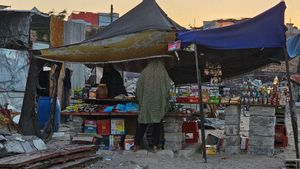JAKARTA - The COVID-19 pandemic has battered the tourism sector. In handling the pandemic, the policy and brake strategies carried out by the government also greatly affect economic recovery in each region. This is especially the case for areas supported by the tourism sector, such as Bali and Yogyakarta.
As is known, before COVID-19 entered the country, Bali was an area with high economic growth. This is because it is supported by foreign tourist visits.
However, for the last 2 years Bali's economy has been the worst-hit among other regions in Indonesia. This is because the government has imposed a brake policy that prohibits foreign tourists from entering.
The Executive Director of CORE Indonesia, Mohammad Faisal said that the complicated conditions for traveling by airplane during the COVID-19 pandemic were also one of the factors causing Bali's economy to contract.
Furthermore, Faisal said because of this, people finally chose to go on vacation to other tourist destinations with travel conditions that were not as complicated as airplanes. As a result, Bali's economic recovery is the slowest.
"Once there is a pandemic, (economic) growth in Bali will be the lowest and the recovery will be the slowest," he said at the '2020 Year End Economic Reflection' event, Wednesday, December 29.
Faisal said that Yogyakarta, which is also an area that relies on the tourism sector, actually experiences different conditions than Bali. This is because a trip to Yogyakarta can be reached by road, either using public transportation or private vehicles.
Moreover, land access to Yogyakarta already has a complete toll road crossing Java, so people from Jabodetabek can travel overland. The travel conditions are not as complicated as when traveling by plane.
"Indeed, there are policy restriction factors that affect it. When air transportation is more stringently restricted than land transportation, this causes demand for tourism services to not be able to go to Bali. So look for areas that can still be (visited), such as Yogyakarta," he said.
Faisal explained that the economic recovery in Bali is also very dependent on air transportation policies, while in Yogyakarta it is not so affected because travel can still be reached by land.
"So this is the difference between the fate of Yogyakarta and Bali," he said.
Yogyakarta's economy is not supported by one sectorEconomic growth in Yogyakarta reached 11.8 percent in the second quarter of 2021. Meanwhile in Bali, it grew at 2.8 percent in the same period. Faisal said this is because the economic structure in Gudeg City is also much more diverse, compared to Bali, which predominantly relies on the tourism sector.
According to him, in Yogyakarta there are still other sectors capable of supporting growth, such as the processing, information and communication industries, the construction sector and the education sector.
"This is a cushion when the tourism sector contracts, so the four sectors are a damper," he said.
Therefore, Faisal suggested that each region should not depend on one sector as the main driver of the economy. The more diverse sectors of economic leverage, the more resilient an area will be when one sector is shaken.
"If you only depend on one sector, then if something goes wrong, who will be shaken again," he explained.
The English, Chinese, Japanese, Arabic, and French versions are automatically generated by the AI. So there may still be inaccuracies in translating, please always see Indonesian as our main language. (system supported by DigitalSiber.id)













